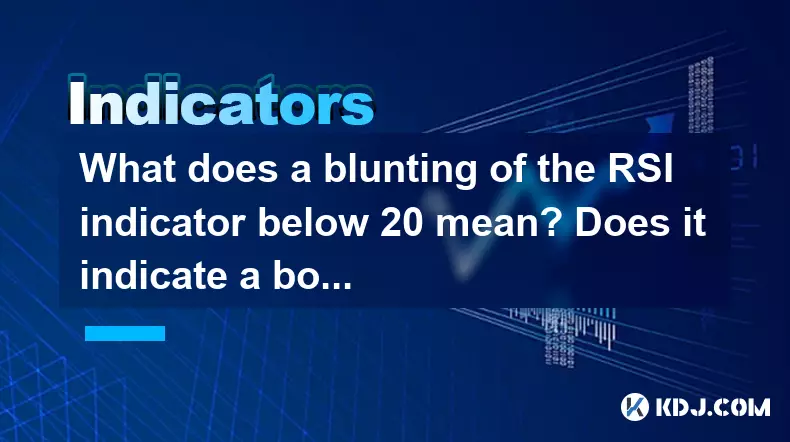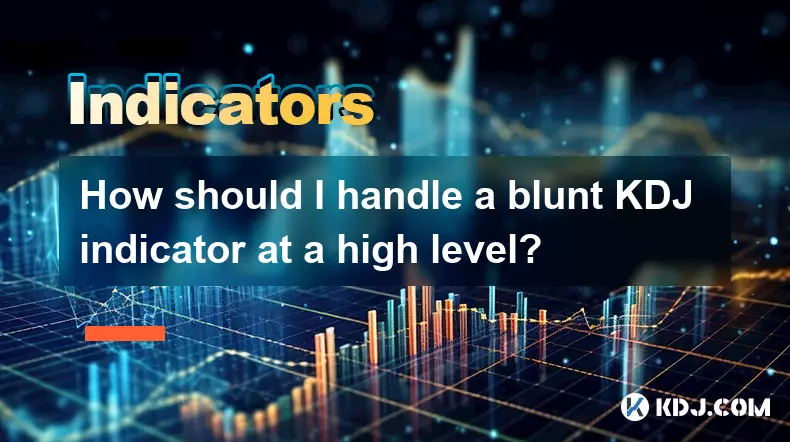-
 bitcoin
bitcoin $117366.968408 USD
0.60% -
 ethereum
ethereum $4611.537173 USD
-0.02% -
 xrp
xrp $3.089373 USD
0.06% -
 tether
tether $1.000286 USD
-0.03% -
 bnb
bnb $986.505381 USD
-0.03% -
 solana
solana $247.629906 USD
0.68% -
 usd-coin
usd-coin $0.999771 USD
-0.03% -
 dogecoin
dogecoin $0.281380 USD
-0.26% -
 cardano
cardano $0.931695 USD
1.71% -
 tron
tron $0.352059 USD
2.40% -
 hyperliquid
hyperliquid $58.226337 USD
-0.94% -
 chainlink
chainlink $24.805082 USD
3.27% -
 avalanche
avalanche $35.625687 USD
10.55% -
 ethena-usde
ethena-usde $1.000922 USD
-0.02% -
 sui
sui $3.883984 USD
2.13%
What does a blunting of the RSI indicator below 20 mean? Does it indicate a bottoming area?
An RSI below 20 in crypto signals extreme oversold conditions, often preceding reversals, but confirmation via volume, price action, and broader context is essential.
Sep 19, 2025 at 08:19 am

Understanding RSI Below 20 in Cryptocurrency Trading
1. The Relative Strength Index (RSI) is a momentum oscillator widely used in the cryptocurrency markets to measure the speed and change of price movements. It operates on a scale from 0 to 100, with readings below 30 typically indicating oversold conditions. When the RSI drops below 20, it signals an extreme level of bearish momentum, suggesting that selling pressure has overwhelmed buying interest across multiple trading sessions.
2. A reading under 20 does not automatically confirm a reversal but highlights exhaustion among sellers. In fast-moving crypto markets, such deep oversold levels often occur during sharp sell-offs triggered by macroeconomic news, exchange outages, or panic liquidations. Traders monitor these zones closely because prolonged stays below 20 can foreshadow a shift in sentiment once short-term capitulation ends.
3. Historical data from major Bitcoin and Ethereum drawdowns show that RSI values beneath 20 frequently precede strong counter-trend rallies. These are not guaranteed turning points, yet they serve as reference areas where aggressive buyers may begin accumulating positions, anticipating mean reversion. The psychological impact of such lows influences market participants who interpret them as potential value zones.
4. Volume analysis becomes critical when assessing RSI extremes. A surge in volume coinciding with an RSI reading below 20 may indicate climax selling—a final wave of fear-driven exits. Once volume declines while prices stabilize, it suggests reduced downward momentum, increasing the probability of a bounce. This dynamic is especially relevant in leveraged crypto markets where forced liquidations amplify volatility.
5. It’s essential to avoid treating sub-20 RSI as a standalone buy signal. False signals are common during extended downtrends. For instance, during the 2022 crypto winter, several assets saw RSI remain under 20 for weeks before establishing sustainable bottoms. Confirmation through price action—such as bullish engulfing patterns or higher lows—is necessary to validate any potential reversal setup.
What Blunting Means in Technical Context
1. Blunting refers to a flattening or stabilization of the RSI line after a steep decline into oversold territory. Instead of continuing to fall, the indicator begins to move sideways or rise slightly, reflecting diminishing downward acceleration. This behavior indicates that the rate of price depreciation is slowing, even if the asset remains deeply undervalued.
2. In chart terms, blunting appears as a rounding bottom formation within the RSI itself. While price may still be making new lows, the RSI fails to reach fresh extremes, creating a divergence. Such hidden strength suggests underlying demand is building, possibly from institutional accumulation or algorithmic rebalancing.
3. A blunted RSI below 20 often marks the transition from panic to equilibrium. During this phase, emotional selling subsides and order book depth improves. Market makers and high-frequency traders may start placing bids, absorbing excess supply without triggering immediate upward moves.
4. This consolidation period allows shorter time frame traders to identify key support levels. If subsequent candles close above minor resistance with rising RSI, it strengthens the case for a near-term bottom. However, absence of follow-through buying can result in renewed breakdowns, particularly if broader market sentiment remains negative.
5. Time-based filters enhance reliability. A blunted RSI sustained over multiple intervals—such as four-hour and daily charts aligning—carries more weight than isolated signals. Multi-timeframe confluence increases confidence that the downtrend is losing steam rather than merely pausing.
Contextual Factors Influencing RSI Interpretation
1. Asset-specific volatility plays a significant role. High-beta altcoins tend to experience more frequent and deeper RSI excursions below 20 compared to stable large-cap tokens. Therefore, identical readings carry different implications depending on the coin’s historical behavior and liquidity profile.
2. Market structure matters. In a bear market cycle, repeated trips below 20 may reflect structural weakness rather than temporary oversold conditions. Conversely, in a bull market correction, such readings are more likely to coincide with healthy pullbacks and swift recoveries.
3. External catalysts like regulatory announcements or protocol upgrades can override technical indicators. Even a perfectly formed RSI blunting pattern may fail if unexpected news reignites selling pressure. Traders must integrate fundamental developments into their analysis framework.
4. Correlation with Bitcoin’s price action cannot be ignored. Most cryptocurrencies exhibit strong beta to BTC; hence, a recovering Bitcoin RSI often pulls other assets upward regardless of their individual technical posture. Monitoring BTC dominance and its RSI trajectory provides additional context.
5. On-chain metrics complement RSI interpretation. Declining exchange reserves coupled with increasing wallet balances during RSI blunting phases suggest accumulation. Similarly, falling funding rates in perpetual futures markets indicate reduced bearish leverage, supporting the argument for a pending reversal.
Frequently Asked Questions
Can RSI stay below 20 for extended periods?Yes, especially during severe bear markets. Prolonged stays under 20 reflect persistent selling pressure and do not guarantee imminent recovery. Duration varies by asset class and prevailing market conditions.
Is a single candlestick reversal enough to confirm a bottom after RSI blunting?No. Single candle patterns lack statistical significance without confirmation from volume, order book dynamics, and multi-session price holding above key levels. Patience is required before assuming trend exhaustion.
How does leverage affect RSI readings in crypto markets?High leverage amplifies both rallies and crashes, causing RSI to swing more violently. Liquidation cascades can push RSI into extreme zones faster than in traditional markets, increasing noise around signals.
Should traders use RSI alone to make decisions?No technical indicator should be used in isolation. Combining RSI with moving averages, volume profiles, and on-chain data improves decision accuracy and reduces false signal risk.
Disclaimer:info@kdj.com
The information provided is not trading advice. kdj.com does not assume any responsibility for any investments made based on the information provided in this article. Cryptocurrencies are highly volatile and it is highly recommended that you invest with caution after thorough research!
If you believe that the content used on this website infringes your copyright, please contact us immediately (info@kdj.com) and we will delete it promptly.
- Bitcoin Whales, Ethereum, and Smart Money: A New Yorker's Take on Crypto's Evolving Landscape
- 2025-09-19 10:25:11
- Bitcoin, Crypto Rally, and September's Endgame: What's the Haps?
- 2025-09-19 10:25:11
- From Change to Riches: That 1 Rupee Coin Could Be Worth 10 Crores!
- 2025-09-19 10:30:00
- ZA Miner: Your Go-To for Cloud Mining and Crypto Income in 2026
- 2025-09-19 10:30:00
- Cryptos in September 2025: Presale Gains and Beyond!
- 2025-09-19 10:30:00
- BNB Price Rockets: Decoding the Cryptocurrency's Surge and Market Factors
- 2025-09-19 10:45:16
Related knowledge

How can I use the psychological line (PSY) to determine market sentiment?
Sep 17,2025 at 02:19pm
Understanding the Psychological Line (PSY) in Cryptocurrency TradingThe Psychological Line, commonly referred to as PSY, is a momentum oscillator used...

What does a death cross of the RSI in the strong zone (above 50) mean?
Sep 17,2025 at 10:54pm
Understanding the Death Cross in RSI Context1. The term 'death cross' is traditionally associated with moving averages, where a short-term average cro...

How should I handle a blunt KDJ indicator at a high level?
Sep 18,2025 at 09:19pm
Understanding a High-Level Blunt KDJ Indicator1. The KDJ indicator, widely used in cryptocurrency trading, combines the stochastic oscillator principl...

What is the Three Crows candlestick pattern? Is it a scary pattern?
Sep 18,2025 at 03:55am
Understanding the Three Crows Candlestick Pattern1. The Three Crows is a bearish reversal pattern in technical analysis, commonly observed after an up...

How can I use the bias to capture oversold rebounds?
Sep 17,2025 at 05:54pm
Understanding Bias in the Context of Crypto Market Movements1. The term 'bias' in cryptocurrency trading refers to a trader’s inclination toward a par...

What is the open-mouthed duck pattern on the MACD indicator?
Sep 17,2025 at 01:18pm
Understanding the Open-Mouthed Duck Pattern on MACDThe MACD (Moving Average Convergence Divergence) indicator is one of the most widely used tools in ...

How can I use the psychological line (PSY) to determine market sentiment?
Sep 17,2025 at 02:19pm
Understanding the Psychological Line (PSY) in Cryptocurrency TradingThe Psychological Line, commonly referred to as PSY, is a momentum oscillator used...

What does a death cross of the RSI in the strong zone (above 50) mean?
Sep 17,2025 at 10:54pm
Understanding the Death Cross in RSI Context1. The term 'death cross' is traditionally associated with moving averages, where a short-term average cro...

How should I handle a blunt KDJ indicator at a high level?
Sep 18,2025 at 09:19pm
Understanding a High-Level Blunt KDJ Indicator1. The KDJ indicator, widely used in cryptocurrency trading, combines the stochastic oscillator principl...

What is the Three Crows candlestick pattern? Is it a scary pattern?
Sep 18,2025 at 03:55am
Understanding the Three Crows Candlestick Pattern1. The Three Crows is a bearish reversal pattern in technical analysis, commonly observed after an up...

How can I use the bias to capture oversold rebounds?
Sep 17,2025 at 05:54pm
Understanding Bias in the Context of Crypto Market Movements1. The term 'bias' in cryptocurrency trading refers to a trader’s inclination toward a par...

What is the open-mouthed duck pattern on the MACD indicator?
Sep 17,2025 at 01:18pm
Understanding the Open-Mouthed Duck Pattern on MACDThe MACD (Moving Average Convergence Divergence) indicator is one of the most widely used tools in ...
See all articles








































































